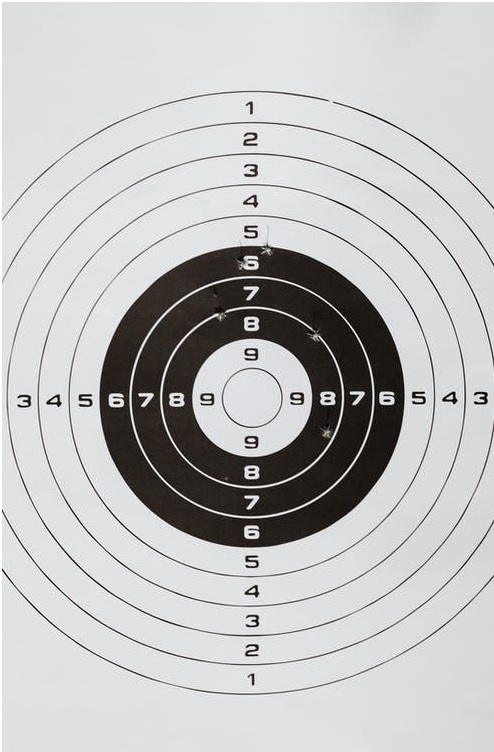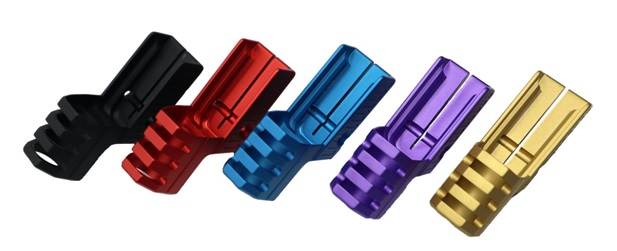
20 Jul 8 Tips to Help You Shrink Your Pistol Groups
For those that learned to shoot rifles and shotguns, making the jump to handguns can serve as a rude awakening.
Establishing tight groups is not easy. Everything is different from firing shoulder-mounted platforms; how to hold the gun, how to manage recoil now that it goes through the wrists instead of through the shoulder, and how minor discrepancies in grip can substantially throw off accuracy.
Here are some of our best suggestions for cultivating confidence and helping to shrink groups when shooting a handgun – ranging from adding a CZ compensator to reduce recoil to learning how to read the signs that a target tells you.
1. Establish a proper grip on the gun
“High and tight” is generally the best way to establish a secure grip on a pistol. For right-handed shooters, this entails placing the web of the right hand as high on the grip as possible and wrapping the rest of your fingers firmly and fully around it.
The support hand should cover the front of the shooting hand and the index knuckle or joint should come up against the bottom of the trigger guard – as high as it can go. As for the thumb of your support hand, extend it forward along the bottom of the frame, just below the slide.
This grip establishes maximum contact with the frame of the handgun and will help you control it better, while also fighting recoil.
2. Slow down
While in a match, you might be scored on speed, however, when you’re training, you need to learn to slow down.
There are two big signs that you’re shooting too fast. One is that your target will look like you’ve peppered it with buckshot; another sign of a speedy shooter is if the grouping lands clustered beneath the point of aim.
Take your time, line up your sights, then fire. Don’t jerk it either. Imagine you are slowly squeezing your finger rearward through the trigger. It should feel like a slow, deliberate, action, not a knee-jerked reaction.
Shooting is not a race. You want to establish rhythm and consistency.
3. Don’t ignore the front sight
Your eyes can only focus on one thing at once. Don’t be staring at your rear sights in an attempt to line them up.
What you should do is look at your front sight post. If you can see a slightly blurred rear aperture, just behind the front sight, then it should be lined up and leveled properly with your rear sight or you wouldn’t be able to see the front sight at all.
Focus on the target, then the front sight post, before firing.
4. Interpret what the target tells you
Where your groups land on the target can tell you a lot about your shooting habits, even if you can’t feel yourself doing them.
For instance, assuming your sights are properly adjusted and your shot strings are still falling low of your point of aim, this could be because you are shooting too quickly. It could also be because you are – intentionally or subconsciously – breaking your wrist down, perhaps in anticipation of recoil.
If your groups are all landing high on the target, this could indicate the exact opposite problem – that you are breaking your wrist up.
Shots that skew to the left and right of the point of aim can also be very telling. For right-handed shooters, if your shots are all landing to the left of your point of aim, this generally indicates that you’re not using enough trigger finger. That is, only the tip of your finger is on the trigger or you are trigger shy.
The reverse is also true. If your shots are all skewing to the right (for right-handed shooters) it generally indicates that there’s too much of your trigger finger in contact with the trigger. It can also mean that you’re squeezing the grip too tightly with your thumb, which is known as “thumbing.” Back off a little.
Shots that land erratically (generally high to the left or right of the point of impact) can also be caused by flinching before the trigger breaks or by anticipating recoil.
5. Be consistent with your breathing
It is also important to establish consistent shooting habits, and one of these is breathing. As long-range shooters know, breathing habits can substantially impact accuracy. The same is true for pistol shooters – although the effects might not be quite as pronounced.
Nonetheless, you should still be consistent. If you fire right after exhaling, do that every time. If you wait a second or two before firing, be consistent with that as well. Do what works for you, but don’t shoot the second after exhaling during one round and then hold your breath on the next.
6.Work on eliminating recoil anticipation
A lot of shooters, especially new shooters, respond to recoil before the trigger breaks, which can throw their shots all over the paper.
Experience usually helps, but so does snap cap training or dry fire training. This can help you develop muscle memory so you can learn not to flinch during live fire. It can also help you better predict when the trigger is going to break. Just make sure that if you practice dry fire or snap cap training, you always observe the cardinal rules of firearm safety.
7.If recoil-fatigue is impacting your handling, consider installing a compensator
Recoil fatigue can also wear out some shooters prematurely. Even if you don’t flinch, if you get worn out from heavy recoil, that can adversely impact your handling and accuracy, too.
A compensator may be able to help. We sell a number of different compensators for popular handguns, including but not limited to Glock, Ruger, HK, S&W, and CZ compensators.
Our compensators are easy to install, available in a number of different colors, and substantially reduce recoil (by up to 50%) without affecting shot power.
All of our Ruger, HK, S&W, Glock, and CZ compensators, like all Anarchy Outdoors products, are also covered by a 100% lifetime guarantee.
8.Consider taking classes
Finally, working with a professional firearms instructor for shooting classes can teach you a lot that it’s difficult for you to teach yourself.
Experienced instructors can help you learn and practice safe handling, adopt a proper stance and grip, develop good trigger control, and can help spot issues that you might not be able to find yourself. The second pair of eyes on you can help you learn more quickly, too.
After all, there is a reason instructors do it for a living.




No Comments